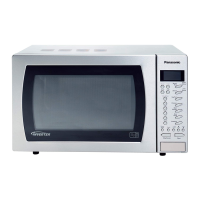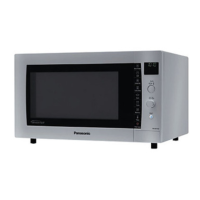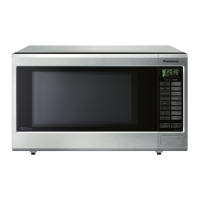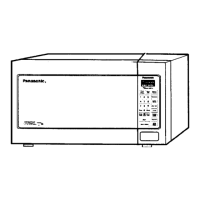Do you have a question about the Panasonic Inverter NN-A574SBBTQ and is the answer not in the manual?
Describes how inverter power supply controls output level via pulse width modulated signal from DPC.
Explains operation when auto control features are selected, determining power level and cooking time.
Ensures the appliance is properly grounded before beginning repair work to avoid electrical hazards.
Highlights dangers of high voltage and temperatures on the inverter PCB and heat sink.
Step-by-step guide for removing and replacing the magnetron, including safety precautions.
Procedure for removing and replacing the inverter PCB, including grounding and support base.
Procedure for removing DPC, membrane keyboard, and escutcheon, with static discharge precautions.
Guidance on replacing low voltage transformer and power relays, emphasizing static discharge.
Steps for removing the fan motor assembly and fan blade from the microwave oven.
Procedure for removing and replacing the door assembly components, ensuring proper fitment.
Steps for removing the turntable motor, including cover, wires, and screws.
Procedure for removing pulley belt, heater hood, pulley A, thermistor, and motor bracket.
Tests continuity of primary/secondary latch switches and power relay B using an ohm meter.
Tests continuity of the short switch and monitor circuit with the oven door open and closed.
Checks magnetron filament continuity and case for shorts to diagnose faults.
Checks continuity of DPC AU switch terminals by tapping keyboard pads.
Advises against repairing the inverter power supply and recommends replacement as a unit.
Instructions for mounting and adjusting latch switches, ensuring correct door closure and play.
Simple method to test microwave output power using water load and measuring temperature rise.
Table for diagnosing no operation, no display, no key input, and no microwave oscillation.
Table for diagnosing a blown 10A fuse, identifying causes like short circuits and faulty components.
Troubleshooting table for low output, buzzing, turntable issues, and operation stopping during cycles.
Procedure for troubleshooting inverter shut down by monitoring input voltage and using self-test mode.
| Inverter Technology | Yes |
|---|---|
| Capacity | 27 Liters |
| Power Consumption | 1350 W |
| Control Type | Touch Control |
| Turntable | Yes |
| Weight | 12 kg |
| Grill | No |
| Convection | No |
| Auto Cook Menu | Yes |
| Child Lock | Yes |
| Turntable Diameter | 315 mm |
| Type | Microwave Oven |
| Power Output | 900 Watts |
| Microwave Power | 900 Watts |












